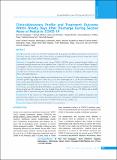Please use this identifier to cite or link to this item:
https://hdl.handle.net/20.500.14356/909Full metadata record
| DC Field | Value | Language |
|---|---|---|
| dc.contributor.author | Chapagain, Ram Hari | - |
| dc.contributor.author | Adhikari, Santosh | - |
| dc.contributor.author | Shrestha, Nisha Jyoti | - |
| dc.contributor.author | Bichha, Muskan | - |
| dc.contributor.author | Maharjan, Jessica | - |
| dc.contributor.author | Thapa, Prabhat | - |
| dc.contributor.author | Sah, Rabindra Kumar | - |
| dc.contributor.author | Basaula, Yuba Nidhi | - |
| dc.date.accessioned | 2023-04-05T06:53:26Z | - |
| dc.date.available | 2023-04-05T06:53:26Z | - |
| dc.date.issued | 2022 | - |
| dc.identifier.citation | ChapagainR. H., AdhikariS., ShresthaN. J., BichhaM., MaharjanJ., ThapaP., SahR. K., & BasaulaY. N. (2022). Clinicolaboratory Profile and Treatment Outcome Within Ninety Days After Discharge During Second Wave of Pediatric COVID-19. Journal of Nepal Health Research Council, 20(02), 475-481. https://doi.org/10.33314/jnhrc.v20i02.4301 | en_US |
| dc.identifier.issn | Print ISSN: 1727-5482; Online ISSN: 1999-6217 | - |
| dc.identifier.uri | http://103.69.126.140:8080/handle/20.500.14356/909 | - |
| dc.description | Original Article | en_US |
| dc.description.abstract | Abstract Background: The second wave of COVID-19 pandemic hit all age groups with different presentations and outcomes. This study aimed to explore the clinical characteristics, investigational findings, hospital outcomes along with a ninety days telephonic follow-up of COVID-19 infection in children. Methods: A longitudinal descriptive study among COVID-19 RT-PCR positive hospital-admitted children was conducted during the second wave of the pandemic from 15 Mar 2021 to 15 Oct 2021 at Kanti Children’s Hospital. Demographics, clinical characteristics, oxygen saturation, comorbidities, need of oxygen, need of ventilator, laboratory investigations, admission to intensive care unit, duration of hospital stay and patient’s outcome (improved and discharged or death) were recorded. A follow up at ninety days from discharge was also done via telephonic call to inquire for any illness and hospital admission. Results: Among the 156 admitted children, males and females were 54.5% and 45.5% with a median age of 15 months and Inter quartile range (IQR) of 63. Thirty-six (23.1%) were underweight and 31 (19.9%) had comorbidities. The most common presenting symptoms were fever 115 (73.7%), cough 50 (32.1%) and vomiting 38 (24.4%). The median (IQR) length of hospital stay was 15 (range of 11–20) days. Oxygen use was seen among 35 (22.4%) cases and 36 (23.1%) cases were admitted to the ICU. Ventilator was required for 7 (4.5%) cases. The number of deaths was 9 (5.8%) during hospital stay. After discharge from the hospital during the ninety days follow-up, 117 children had no health problems while 42 reported having some health problems and 5 died after discharge. Conclusions: In the second wave of the pandemic, only symptomatic children were admitted. Respiratory and gastrointestinal symptoms were common among the admitted cases. The majority of admitted cases had a good outcome and had no other health problems attributable to COVID-19 till ninety days of follow-up. Keywords: Pediatric COVID-19; RT-PCR; SARS-CoV-2; second wave | en_US |
| dc.language.iso | en | en_US |
| dc.publisher | Nepal Health Research Council | en_US |
| dc.relation.ispartofseries | April-June, 2022;4301 | - |
| dc.subject | Pediatric COVID-19 | en_US |
| dc.subject | RT-PCR | en_US |
| dc.subject | SARS-CoV-2 | en_US |
| dc.subject | Second wave | en_US |
| dc.title | Clinicolaboratory Profile and Treatment Outcome Within Ninety Days After Discharge During Second Wave of Pediatric COVID-19 | en_US |
| dc.type | Journal Article | en_US |
| Appears in Collections: | Vol 20 No 02 Issue 55 April-June, 2022 | |
Files in This Item:
| File | Description | Size | Format | |
|---|---|---|---|---|
| 4301-Manuscript-29701-1-10-20221103.pdf | Full Article. | 219.05 kB | Adobe PDF |  View/Open |
Items in DSpace are protected by copyright, with all rights reserved, unless otherwise indicated.
